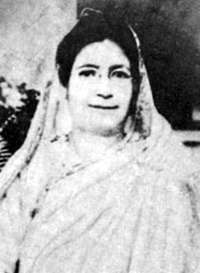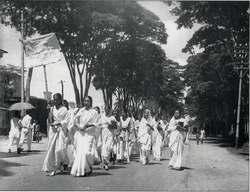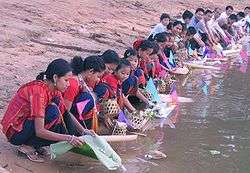Women in Bangladesh
 Begum Rokeya, was a prolific writer and a social worker in undivided Bengal . She is most famous for her efforts on behalf of gender equality and other social issues. | |
| Gender Inequality Index | |
|---|---|
| Value | 0.518 (2012) |
| Rank | 107th [1] |
| Maternal mortality (per 100,000) | 240 (2010) |
| Women in parliament | 19.7% (2012) |
| Females over 25 with secondary education | 30.8% (2010) |
| Women in labour force | 57.2% (2011) |
| Global Gender Gap Index[2] | |
| Value | 0.6848 (2013) |
| Rank | 75th out of 144 |
The status of women in Bangladesh is defined by struggle to massive improvement over the years. The Bangladeshi women have made massive gains since the country gained its independence in 1971. The past four decades have seen increased political empowerment for women, better job prospects, improved education and the adoption of new laws to protect their rights. As of 2013, the Prime Minister of Bangladesh, the Speaker of Parliament, the Leader of the Opposition and the Foreign minister were women.
History
Available data on health, nutrition, education, and economic performance indicated that in the 1980s the status of women in Bangladesh remained considerably inferior to that of men. Women, in custom and practice, remained subordinate to men in almost all aspects of their lives; greater autonomy was the privilege of the rich or the necessity of the very poor.
Most women's lives remained centered on their traditional roles, and they had limited access to markets, productive services, education, health care, and local government. This lack of opportunities contributed to high fertility patterns, which diminished family well-being, contributed to the malnourishment and generally poor health of children, and frustrated educational and other national development goals. In fact, acute poverty at the margin appeared to be hitting hardest at women. As long as women's access to health care, education, and training remained limited, prospects for improved productivity among the female population remained poor.
About 82 percent of women lived in rural areas in the late 1980s. The majority of rural women, perhaps 70 percent, were in small cultivator, tenant, and landless households; many worked as laborers part-time or seasonally, usually in post-harvest activities, and received payment in kind or in meager cash wages. Another 20 percent, mostly in poor landless households, depended on casual labor, gleaning, begging, and other irregular sources of income; typically, their income was essential to household survival. The remaining 10 percent of women were in households mainly in the professional, trading, or large-scale landowning categories, and they usually did not work outside the home.
The economic contribution of women was substantial but largely unacknowledged. Women in rural areas were responsible for most of the post-harvest work, which was done in the chula, and for keeping livestock, poultry, and small gardens. Women in cities relied on domestic and traditional jobs, but in the 1980s they increasingly worked in manufacturing jobs, especially in the readymade garment industry. Those with more education worked in government, health care, and teaching, but their numbers remained very small. Continuing high rates of population growth and the declining availability of work based in the chula meant that more women sought employment outside the home. Accordingly, the female labor force participation rate doubled between 1974 and 1984, when it reached nearly 8 percent. Female wage rates in the 1980s were low, typically ranging between 20 and 30 percent of male wage rates.
Education and economic development
Education
The literacy rate in Bangladesh is lower for females (55.1%) compared to males (62.5%) - 2012 estimates for population aged 15 and over.[3]
During the past decades, Bangladesh has improved its education policies; and the access of girls to education has increased. In the 1990s, girls’ enrollment in primary school has increased rapidly. Although there is now gender parity in enrollments at the primary and lower secondary school level, the percentage of girls drops in the later secondary school years.[4]
Workforce participation
Women in Bangladesh are engaged in many work activities, from domestic work inside the home, to outside paid work. Women's work is often undervalued and underreported.[5]
Land and property rights
Women's inheritance rights are poor: discriminatory laws and patriarchal social norms make it difficult for many women to have access to land.[6] Most women inherit according to the local interpretations of Sharia Law.[6]
Crimes against women
Rape
Bengali settlers and soldiers in the Chittagong Hill Tracts have raped native Jumma (Chakma) women "with impunity" with the Bangladeshi security forces doing little to protect the Jummas and instead assisting the rapists and settlers.[7]
The indigenous Buddhist and Hindu Jummas of Sino-Tibetan background have been targeted by the Bangladeshi government with massive amounts of violence and genocidal policies as ethnic Bengali settlers swarmed into Jumma lands, seized control and massacred them with the Bangladeshi military engaging in mass rape of women, massacres of entire villages and attacks on Hindu and Buddhist religious sites with deliberate targeting of monks and nuns.[8]
In Bangladesh's rural areas rape has been committed by 1/8th of the men.[9]
Child marriage
Bangladesh has one of the highest rates of child marriage in the world.[10] The practice of dowry, although illegal, contributes to this phenomenon.[11] 29% of girls get married before age 15 and 65% before the age of 18.[12] Government action has had little effect, and has been contradictory: although the government has pledged to end child marriage by 2041, the Prime Minister in 2015 attempted to lower the age of marriage for girls from 18 to 16.[12] An exception to the law was instituted so that marriage at 16 is permitted with parental consent.[13]
Domestic violence
In 2010, Bangladesh enacted the Domestic Violence (Prevention and Protection) Act, 2010.[14] Domestic violence (DV) is accepted by a significant percentage of the population: in the 2011 DHS survey, 32.5% of women said that a husband is justified in hitting or beating his wife for specific reasons (the most common reason given was if the wife "argues with him" - at 22.4%).[15] In recent years woman getting violence abuse from men has decreased significantly and is considerably low compared to south Asian countries like Sri Lanka Nepal and India.[16]
Dowry
Dowry violence is a problem in Bangladesh. The country has taken action against the practice of dowry through laws such as Dowry Prohibition Act, 1980; Dowry Prohibition (Amendment) Ordinance, 1982; and Dowry Prohibition (Amendment) Ordinance, 1986. However, abuses regarding dowry continue, with the legal enforcement against dowry being weak.[17]
Sexual harassment and Eve teasing
Eve-teasing is an euphemism used throughout South Asia, in countries such as Pakistan,[18] India and Bangladesh,[19] for public sexual harassment or molestation (often known as "street harassment") of women by men, where Eve alludes to the very first woman, according to the Biblical creation story.[20] Sexual harassment affects many women in Bangladesh, especially teenage girls, where the girls are intimidated in the streets, are shouted obscenities at, laughed at, or grabbed by their clothes.[21]
Other concerns
Health
The maternal mortality rate in Bangladesh is 240 deaths/100,000 live births (as of 2010).[22] Sexually transmitted infections are relatively common,[23] although the rate of HIV/AIDS is low.[24] A 2014 study found that Bangladeshi women' knowledge about different diseases is very poor.[25] Bangladesh has recently expanded training programs of midwives in order to improve reproductive health and outcomes.[26]
Family planning
Already in the 1990s, family planning was recognized as very important in Bangladesh.[27] The total fertility rate (TFR) is 2.45 children born/woman (estimates as of 2014).[28]
Gallery
 Bangladeshi women form up a rally at the first anniversary of Bengali Language Movement in Dhaka University in 1953.
Bangladeshi women form up a rally at the first anniversary of Bengali Language Movement in Dhaka University in 1953.
- International Women's Day rally in Dhaka.
- Bangladeshi girl cadets in Feni Girls Cadet College.
- Bangladeshi women at Whitechapel, London. United Kingdom is home to one of the largest Bangladeshi communities outside Bangladesh and the largest outside Asia.
- Female members of a Bangladeshi family seen at Jabal al-Noor, Makkah, Saudi Arabia. 3.5 million Bangladeshis in Saudi Arabia, mostly migrant workers and their family members in some cases, make up the largest Bangladeshi population outside Bangladesh (See Bangladeshis in the Middle East).
 Bangladeshi women of the hill tracts.
Bangladeshi women of the hill tracts. A Bangladeshi woman participating in Durga Puja.
A Bangladeshi woman participating in Durga Puja. Bangladeshi women undergoing an adult education programme by Bangladesh Youth Leadership Centre.
Bangladeshi women undergoing an adult education programme by Bangladesh Youth Leadership Centre.
References
- ↑ "Human Development Report 2014" (PDF). The United Nations. Retrieved 24 July 2014.
- ↑ "The Global Gender Gap Report 2013" (PDF). World Economic Forum. pp. 12–13.
- ↑ "The World Factbook". www.cia.gov. Retrieved 2016-08-02.
- ↑ "UNICEF Bangladesh - Girls' Education - Girls' Education Strategy for Bangladesh". www.unicef.org. Retrieved 2016-08-02.
- ↑ http://www.lse.ac.uk/genderInstitute/about/resourcesNailaKabeer/mahmudAndTasneemTheUnderreportingOfWomensEconomicActivity.pdf
- 1 2 http://www.ohchr.org/Documents/HRBodies/CEDAW/RuralWomen/CDABangladesh.pdf
- ↑ McEvoy, Mark (3 April 2014). "Chittagong Hill Tracts of Bangladesh – rapists act with impunity". Survival International - The movement for tribal peoples.
- ↑ Iqbal, Jamil M. (2 November 2009). "The fate of the Chittagong Hill Tracts tribes of Bangladesh". In Defence of Marxism.
- ↑ "Bangladeshi Gang Rape". Vice News. November 21, 2014.
- ↑ http://www.unicef.org/sowc09/docs/SOWC09-CountryExample-Mali.pdf
- ↑ Early marriage, UNICEF, retrieved 27 August 2015
- 1 2 Bangladesh: Girls Damaged by Child Marriage: Stop Plan to Lower Marriage Age to 16, Human Rights Watch, 9 June 2015, retrieved 27 August 2015
- ↑ Mansura Hossain (Mar 7, 2015), Age of marriage 18, but 16 with parental consent, Prothom Alo, retrieved 27 August 2015
- ↑ http://phrplanbd.org/attachments/article/42/DV%20Act_Engling%20Translation%20%28unofficial%29.pdf
- ↑ http://dhsprogram.com/pubs/pdf/FR265/FR265.pdf
- ↑ "57% of boys, 53% of girls think wife beating is justified - Times of India". Retrieved 2016-08-02.
- ↑ http://www.irinnews.org/report/86100/bangladesh-dowry-violence-continues-unabated
- ↑ Afridi, Tehniya S (8 July 2013). "Eve teasing: The power game". The Express Tribune. Pakistan. Retrieved 9 February 2015.
- ↑ "Eve-teasers beat dead youth in Dhaka", Daily Star, 11 October 2014.
- ↑ Barrett, Grant (2006), "Eve Teasing", The Official Dictionary of Unofficial English, McGraw-Hill Professional, p. 109, ISBN 0-07-145804-2
- ↑ "When sexual harassment leads to suicide". 2010-12-13. Retrieved 2016-08-02.
- ↑ "The World Factbook". www.cia.gov. Retrieved 2016-08-02.
- ↑ Gibney, L; Macaluso, M; Kirk, K; Hassan, MS; Schwebke, J; Vermund, SH; Choudhury, P (2001). "Prevalence of infectious diseases in Bangladeshi women living adjacent to a truck stand: HIV/STD/hepatitis/genital tract infections". Sex Transm Infect. 77: 344–50. doi:10.1136/sti.77.5.344. PMC 1744386
 . PMID 11588280.
. PMID 11588280. - ↑ "The World Factbook". www.cia.gov. Retrieved 2016-08-02.
- ↑ http://www.biomedcentral.com/content/pdf/1471-2458-14-775.pdf
- ↑ http://www.who.int/features/2014/midwifes-bangladesh/en/
- ↑ http://dspace.icddrb.org/dspace/bitstream/123456789/2561/1/Bangladesh+family+planning+programme,lesson+learned+and+direction+for+the+future,+monograph+6.pdf
- ↑ "The World Factbook". www.cia.gov. Retrieved 2016-08-02.
![]() This article incorporates public domain material from the Library of Congress Country Studies website http://lcweb2.loc.gov/frd/cs/.
This article incorporates public domain material from the Library of Congress Country Studies website http://lcweb2.loc.gov/frd/cs/.
External links
| Wikimedia Commons has media related to Women of Bangladesh. |

